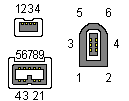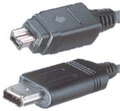FireWire (also known as i.Link or IEEE 1394) is a personal computer / consumer electronic serial bus interface standard offering high-speed communications and isochronous real-time data services. The IEEE 1394-1995 standard for the High Performance Serial Bus defines a serial data transfer protocol. The capabilities of the 1394 bus are sufficient to support a variety of high-end digital audio/video applications, such as consumer audio/video device control and signal routing, home networking, nonlinear DV editing, and 32-channel (or more) digital audio mixing.
| 4-pin connector |
6-pin connector |
9-pin connector |
Name | Description | color of wire in cable |
|---|---|---|---|---|---|
| 1 | 8 | Power | Unregulated DC; 30 V no load | white | |
| 2 | 6 | Ground | Ground return for power and inner cable shield | black | |
| 1 | 3 | 1 | TPB- | Twisted-pair B, differential signals | red |
| 2 | 4 | 2 | TPB+ | Twisted-pair B, differential signals | green |
| 3 | 5 | 3 | TPA- | Twisted-pair A, differential signals | orange |
| 4 | 6 | 4 | TPA+ | Twisted-pair A, differential signals | blue |
| 5 | A shield | ||||
| 7 | - | ||||
| 9 | B shield | ||||
| Shell | Outer | cable shield | |||
In a regular FireWire cable line A always connected to line B and vice versa (minus to minus, plus to plus).
FireWire can connect together up to 63 peripherals in an acyclic network structure (as opposed to SCSIs linear structure). It allows peer-to-peer device communication, such as communication between a scanner and a printer, to take place without using system memory or the CPU. FireWire also supports multiple hosts per bus, and through software IP networks can be formed between FireWire-linked computers. It is designed to support plug-and-play and hot swapping. Its six-wire cable is not only more convenient than SCSI cables but can supply up to 45 watts of power per port, allowing moderate-consumption devices to operate without a separate power cord. (Sony-inspired iLink usually deletes the power part of the cable/connector system and only uses a 4-pin connector.)
Firewire standards
FireWire 400 (IEEE 1394-1995, IEEE 1394a-2000)
FireWire 400 can transfer data between devices at 100, 200, or 400 Mbit/s data rates (actually 98.304, 196.608, or 393.216 Mbit/s, but commonly referred to as S100, S200, and S400). Cable length is limited to 4.5 metres but up to 16 cables can be daisy-chained yielding a total length of 72 meters under the specification. The 6-conductor powered connector, now referred to as an alpha connector, adds power output to support external devices. Typically a device can pull about 7 to 8 watts from the port; however, the voltage varies significantly from different devices. Voltage is specified as unregulated and should nominally be about 25 volts (range 24 to 30). Apple's implementation on laptops is typically related to battery power and can be as low as 9 V.
FireWire 800 (IEEE 1394b-2002)
FireWire 800 was introduced by Apple in 2003, allows an increase to 786.432 Mbit/s with backwards compatibility to the slower rates and 6-pin connectors of FireWire 400. However, while the IEEE 1394a and IEEE 1394b standards are compatible, FireWire 800's connector, referred to as a beta connector, is different from FireWire 400's alpha connectors, making legacy cables incompatible. A bilingual cable allows the connection of older devices to the newer port. The full IEEE 1394b specification supports data rates up to 3200 Mbit/s (i.e., 400 megabytes/s) over beta-mode or optical connections up to 100 metres (330 ft) in length. Standard Category 5e unshielded twisted pair supports 100 metres (330 ft) at S100.
FireWire S800T (IEEE 1394c-2006)
Provided a major technical improvement, namely new port specification that provides 800 Mbit/s over the same 8P8C (Ethernet) connectors with Category 5e cable, which is specified in IEEE 802.3 clause 40 (gigabit Ethernet over copper twisted pair) along with a corresponding automatic negotiation that allows the same port to connect to either IEEE Std 1394 or IEEE 802.3 (Ethernet) devices.Though the potential for a combined Ethernet and FireWire 8P8C port is intriguing, as of November 2008, no products or chipsets include this capability
FireWire S1600 and S3200
The 1394 Trade Association announced that products would be available before the end of 2008 using the S1600 and S3200 modes that, for the most part, had already been defined in 1394b and were further clarified in IEEE Std. 1394-2008. The 1.572864 Gbit/s and 3.145728 Gbit/s devices use the same 9-conductor beta connectors as the existing FireWire 800 and are fully compatible with existing S400 and S800 devices. It competes with USB 3.0. S1600 (Symwave) and S3200 (Dap Technology) development units have been made, however because of FPGA technology DapTechnology targeted S1600 implementations first with S3200 not becoming commercially available until 2012.
IEEE - 1394 Features
- Real-time data transfer for multimedia applications
- Live connection/disconnection without data loss or interruption (hot-plug)
- Automatic configuration supporting plug and play
- Freeform network topology allowing mixing branches and daisy-chains
- No separate line terminators required
- Guaranteed bandwidth assignments for real-time applications
- Common connectors for different devices and applications
IEEE-1394 is based on Apple Computers original 1394 bus, which was intended as a low-cost replacement for or supplement to the SCSI bus that is a standard feature of Macintosh and PowerMac computers.
IEEE-1394 Architecture
The IEEE 1394-1995 standard defines two bus categories: backplane and cable. The backplane bus is designed to supplement parallel bus structures by providing an alternate serial communication path between devices plugged into the backplane. The cable bus, is a non-cyclic network with finite branches, consisting of bus bridges and nodes (cable devices). Six-bit Node_IDs allow up to 63 nodes to be connected to a single bus bridge; 10 bit Bus_IDs accommodate up to 1,023 bridges in a system. This means, as an example, that the limit is 63 devices connected to a conventional 1394 adapter card in a PC.
Each node usually have three connectors, although the standard provides for 1 to 27 connector per a devices physical layer or PHY. Up to 16 nodes can be daisy-chained through the connectors with standard cables up to 4.5 m in length for a total standard cable length of 72 m. 1394 truly qualifies as a plug-and-play bus.
The 1394 cable standard defines three signaling rates: 98.304, 196.608, and 393.216 Mbps (megabits per second; MBps in this paper refers to megabytes per second.) These rates are rounded to 100, 200, and 400 Mbps, respectively, in this paper and are referred to in the 1394 standard as S100, S200 and S400. Consumer DV gear uses S100 speeds, but most 1394 PC adapter cards support the S200 rate. The signaling rate for the entire bus ordinarily is governed by the slowest active node; however, if a bus master (controller) implements a Topology_Map and a Speed_Map for specific node pairs, the bus can support multiple signaling speeds between individual pairs.
FireWire cables and connectors
Standard bus interconnections are made with a 6-conductor cable containing two separately-shielded twisted pair transmission lines for signaling, two power conductors, and an overall shield. The two twisted pairs are crossed in each cable assembly to create a transmit-receive connection. The power conductors (8 to 40 v, 1.5 a max.) supply power to the physical layer in isolated devices. Transformer or capacitative coupling is used to provide galvanic isolation; transformer coupling provides 500 volts and lower-cost capacitative coupling offers 60 volts of ground potential difference isolation. Connectors are derived from the GameBoy design.
Firewire bus details
Isochronous or asynchronous data transfers are possible. The isochronous data transport of the 1394 bus provides the guaranteed bandwidth and latency required for high-speed data transfer over multiple channels. On bus reset or when an isochronous node is added to the bus, the node requests a bandwidth allocation. If adequate bandwidth is not available, the requesting device is expected to repeat its request periodically. As an example of bus allocation, video acquisition for non-linear digital editing requires only a single isochronous channel, plus an asynchronous path for device control.
IEEE 1394 is a standard, platform-independent solution. Its features represent an evolutionary improvement over current I/O interfaces and provide connectivity solutions for many markets. Legacy I/O bridges attach serial and parallel interfaces to 1394. ANSI SCSI-3 provides a migration path for parallel SCSI to move to IEEE 1394. IEEE 1394 can interface with the higher layers of the new parallel port standard, IEEE 1284. Although IEEE 1284s 4 to 32 Mbps transfer rate is lower than that of 1394, 1284 finds application in printer connectivity since it is backward compatible with the existing Centronics parallel port. IEEE 1394 devices of differing transport rates may be interconnected, allowing backward compatibility with devices having slower transport rates. This feature allows 100 Mbps devices purchased today to operate properly in future bus configurations involving 200 and 400 Mbps devices.



 правильная
правильная с ошибками
с ошибками